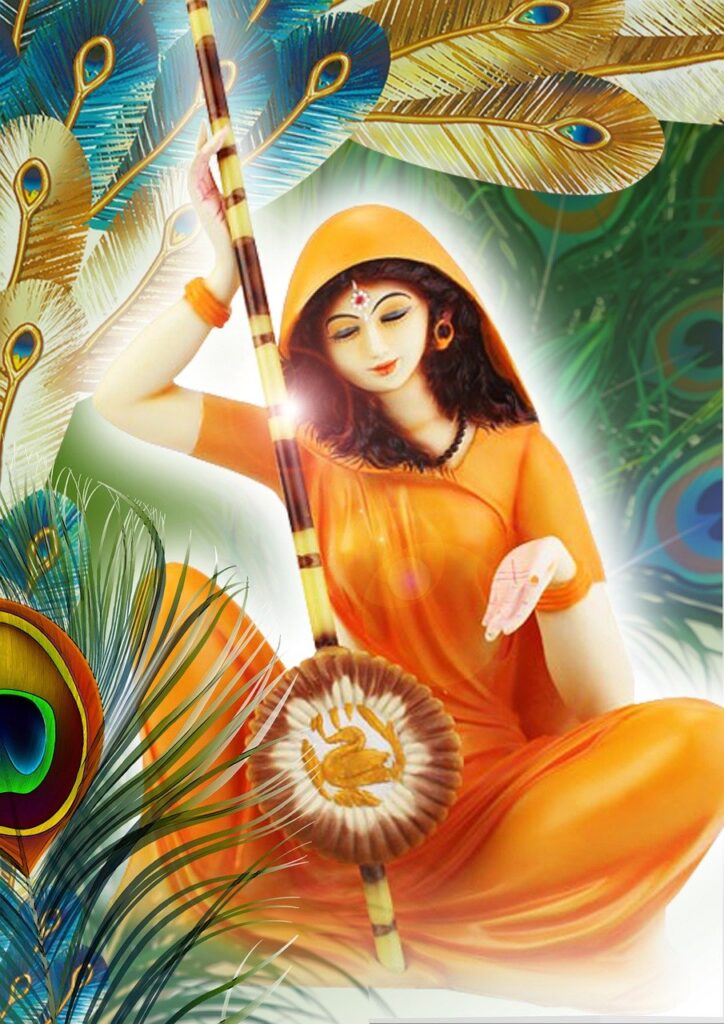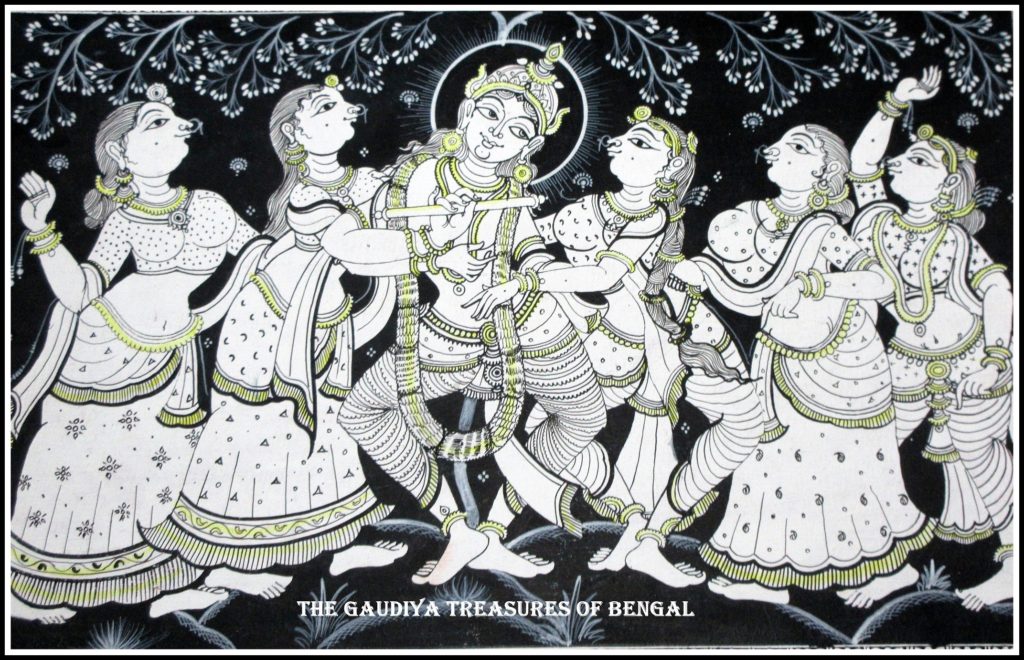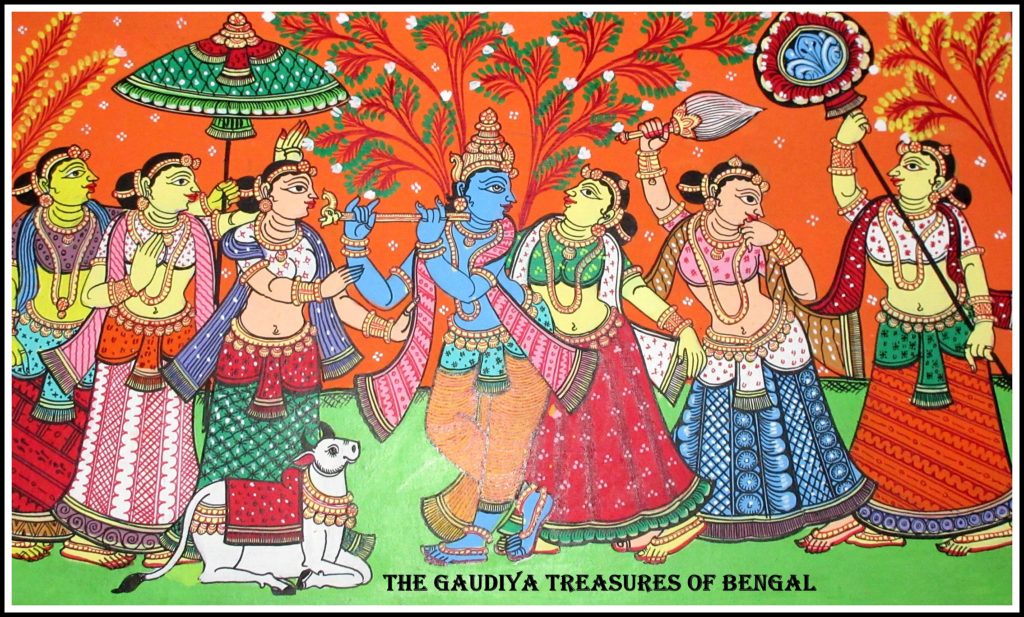What is Raganuga Bhakti ?
In course of everyday interactions within this remarkable world, the conditioned living entity grows a strong love and affection towards material objects. The soul is deceived with material obsessions as his eyes restlessly cross over from one alluring object to another. The endless material infatuations of this world hold him captive forever. However, when this same love is dovetailed towards Krishna, the Supreme Personality of Godhead, and the Lord becomes the sole objective of his life, then this love assumes the form of ‘Raga Bhakti’. Srila Rupa Goswami defines ‘Raga’ in ‘Bhakti Rasamrita Sindhu’ as follows :
Iste svarasiki rajah
Paramavistata bhavet
Tan mayi ya behaved bhakti
Satra ragatmikodita
(Bhakti rasamrita sindhu – 1.2.272)
–
Raga is complete absorption in one’s most worshipable object, tempered with emotions that are in accordance with one’s innate mood (sva-rasiki) of transcendental love. When devotion to Sri Krishna is fully complemented by such Raga, it is described as Ragatmika bhakti.virajantim abhivyaktam vrajavasi-janadishu
ragatmikam anusrita ya sa raganugocyate
( Bhakti rasamrita sindhu 1.2.270)
–
The devotion possessed by the eternal associates of Lord Krishna in Vrindavana is known as the devotion filled with loving attachment (ragatmika-bhakti). While the devotion following in the wake of this ragatmika bhakti is called raganuga-bhakti.
To be concise, the unquenchable thirst to love Sri Krishna falls within the purview of ‘Raga’. The eternal associates of Krishna in Vrindavana (the supreme transcendental abode) are forever immersed in various spiritual mellows that are full of ‘Raga’ (spontaneous divine love). The devotion possessed by these eternal associates of the Supreme Lord is classified as ‘Ragatmika’. While the devotion of those who are keen to attain the bhava (ecstatic emotions) possessed by these residents of Vrindavana, is classified as ‘Raganuga’. ‘Raganuga’ bhakti hence takes shelter of and follows the footsteps of the ‘Raga’ and ‘bhava’ (spiritual emotions) of the ‘Ragatmika’ devotee.
Vaidhi Bhakti and Raganuga Bhakti
Those who are yet to savor the spiritual emotions of ‘Raga’ (spontaneous love for Krishna), must seek the injunctions of the Vedic scriptures to enhance their devotion. The devotion that is triggered by following the scriptural injunctions is called Vaidhi-bhakti, while that which is unfolded by spiritual greed alone, is called ‘Raganuga’ bhakti. The word ‘vaidhi’ is derived from the Sanskrit word ‘vidhi’, referring to the commandments of the scriptures. The word ‘Raganuga’ is a compound of two words, namely Raga, ‘loving attachment’, and ‘anuga’ which implies ‘following in the footsteps of’. Bhakti Rasamritu sindhu further clarifies –
yatra raganavaptatvat pravrittir upajayate
sasanenaiva sastrasya sa vaidhi-bhaktir ucyate
(Bhakti rasamrita sindhu 1.2.6)
–
That devotion which knows no attachment or greed, but which is prompted by the commandments of the scriptures, is called vaidhi-bhakti.
Awe, reverence, and faith are the vital principles of Vaidhi bhakti whilst ever-increasing spiritual greed to savor the pastimes of Sri Krishna is the hallmark of ‘Raganuga’ bhakti. ‘Vaidhi sraddha’ or implicit faith upon Vedic scriptural injunctions qualifies one for practicing ‘Vaidhi bhakti’. Similarly, ‘lobhamayi sraddha’, or faith upon Sri Krishna, driven by intense spiritual greed, qualifies one to enter the realm of ‘Raganuga’ bhakti.

It must be clarified, that all the exercises of Vaidhi bhakti i.e, sravanam (hearing), kirtanam (chanting), etc also exist within the devotional practices of ‘Raganuga’ bhakti. The Raganuga devotee savors the eternal service of Sri Krishna within Himself under the guidance of his chosen Ragatmika bhakta (eternal associate of the Supreme Lord), while externally he continues executing Vaidhi bhakti (sadhana bhakti) in accordance with the scriptural rules and regulations. The same is echoed, though more concisely, in an earlier work of Sri Krishna Das Kaviraja:
bahya, antara, ihara dui ta sadhana
bahye sadhaka-dehe kare sravana-kirtana
mane nija-siddha-deha kariya bhavana
ratri-dine kare vraje krishnera sevana
(Chaitanya Charitamrita 2.22.156-157)
–
There are two processes by which one may execute this Raganuga bhakti – external and internal. Externally, in the sadhaka-form, one engages in hearing and chanting like a neophyte and executes all the scriptural injunctions, and within the mind, in one’s own siddha-form, day and night one thinks of and serves Sri Krishna in Vrindavana in his particular way.
The path of Raganuga bhakti, however, is considered superior as it produces the results much quicker as compared to the process of Vaidhi bhakti. Results are achieved with far less effort in the path of Raga. The numerous scriptural prohibitions and directions in the case of Vaidhi bhakti make it weak whereas the spontaneous love and natural attraction which characterizes the path of Raganuga bhakti, make it firm and sturdy. When one’s consciousness has been cleansed of the pollution of material modes of goodness (satva), passion (rajas), and ignorance (tamas), one naturally feels a growing inspiration to serve a particular eternal associate of the Lord. The intense spiritual greed which characterizes Raganuga Bhakti, automatically reveals one’s eternal spiritual nature.
Divisions of Ragatmika Bhakti
Ragatmika Bhakti can be classified into two distinct categories – Kamarupa bhakti and Sambandha-rupa bhakti. One should realize that ragatmika bhakti is the exclusive domain of the Nitya-siddhas (perfected souls) of Vrindavana and their unalloyed transcendental love finds its natural expression in Kamarupa and Sambandha-rupa bhakti.
Kama-rupa Bhakti is the love (devotion) born out of intense spiritual desire. It produces an intrinsic thirst for a conjugal relationship with Krishna only for the purpose of giving happiness to Krishna. It involves a complete and divine absorption of one’s transcendental body, mind and heart in the service of Krishna. The word ‘Kama’, which translates to ‘lust’, may indicate the desire to enjoy selfishly and materially. However, when this same mood manifests in Ragatmika bhakti, it translates to transcendental love for Krishna, and is completely devoid of the material pollution of selfishness. ‘Kamarupa bhakti’ is selfless transcendental love, wherein every single effort of the lover, the devotee, is directed to satisfy Sri Krishna. All activities for self-worship and sense gratification are absent in this case. Even if there are elements of desire for personal happiness, these are ultimately engaged for Krishna’s pleasure. This superexcellent love is perfectly portrayed in the gopis of Vrindavana. The love of the Gopis is truly transcendental, pure, and untouched by mundane impurities. It can never be compared to the lust of conditioned living entities of this world, which is gross and self-centered.

Sambandha Rupa Bhakti is inspired by fully identifying oneself as the parent, friend, or servant of Krishna in vatsalya, sakhya, or dasya rasas (divine mellows). In the Vrsni dynasty, Krishna’s parents, Devaki, Vasudeva, and other elders manifest such a parental relationship. However, the original manifestation of this mood is in Vrindavana as exhibited by Yasoda, Nanda Maharaj, and other elders of Vraja.
One of the key differences between these two kinds of Ragatmika bhakti is that the aspect of ‘keli’ or amorous overtures and passion is entirely absent in the case of Sambandha rupa bhakti. When the element of intense spiritual greed of uniting with Krishna combines with pure transcendental love, the two emotions amalgamate to give rise to Kamarupa Ragatmika bhakti, which only exists in Madhurya rasa and not in other mellows. The damsels of Vrindavana are the sole-inheritors and possessors of Kama-rupa Bhakti.
Divisions of Raganuga Bhakti
Following the footsteps of the two types of Ragatmika devotees, Raganuga bhakti can also be divided into two –
1) Sambandhanuga-bhakti : Sambandhanuga-bhakti follows in the footsteps of Sambandharupa ragatmika bhakti. This is a type of devotion where a practitioner constantly identifies with and meditates on his relationship (sambandha) with Sri Krishna as either a parent, friend or servant. Those who wish to serve Krishna as His parents emulate devotees like Nanda maharaj or mother Yashoda. Those who desire to serve as the Lord’s friends follow in the footsteps of Subala, Sridama, etc. And those who are attracted to serve the Lord as His servants emulate the sublime service of Raktaka, Patraka, etc.
2) Kamanuga-bhakti : Kamanuga bhakti follows in the footsteps of Kama-rupa Ragatmika bhakti. This is a type of devotion where a sadhaka is filled with longing, thirst and eagerness to serve and follow (not imitate) the Kama-rupa gopis of Vrindavan like Srimati Radharani, Lalita, Vishakha, Sri Rupa, Rati manjari, etc.
Kamanuga bhakti can be further subdivided into two – Sambhogecchamayi and tad-tad bhaveccha mayi. Sambhogecchamayi is the want to enter the transcendental amorous pastimes of the damsels of Vrindavana and satisfy Krishna therein. The desire to enter into such pleasurable dealings and unite with Krishna is called Sambhogecchamayi.

Tad-tad bhaveccha mayi is the desire to develop profound transcendental love, full of sweetness and amorous feelings for Sri Krishna, in emulation of the leaders of the various damsels of Vrindavana. Here the devotee is filled with the desire to taste the sweet mood of love (bhava) of a particular Vraja-gopi like Sri Radha, Sri Rupa, Rati manjari, etc.
Both Kamanuga and the Sambandhanuga raganuga bhakti arise by beholding the beautiful deity form of Krishna and by hearing of His glorious pastimes, which in turn triggers the urge to experience the bhava (ecstatic emotions) intrinsic to these pastimes. The practitioner then embarks on a journey practicing either Kamanuga or Sambandhanuga bhakti as per his spiritual inclination.
